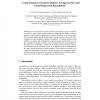Free Online Productivity Tools
i2Speak
i2Symbol
i2OCR
iTex2Img
iWeb2Print
iWeb2Shot
i2Type
iPdf2Split
iPdf2Merge
i2Bopomofo
i2Arabic
i2Style
i2Image
i2PDF
iLatex2Rtf
Sci2ools
AVBPA
2001
Springer
2001
Springer
Using Mixture Covariance Matrices to Improve Face and Facial Expression Recognitions
In several pattern recognition problems, particularly in image recognition ones, there are often a large number of features available, but the number of training samples for each pattern is significantly less than the dimension of the feature space. This statement implies that the sample group covariance matrices often used in the Gaussian maximum probability classifier are singular. A common solution to this problem is to assume that all groups have equal covariance matrices and to use as their estimates the pooled covariance matrix calculated from the whole training set. This paper uses an alternative estimate for the sample group covariance matrices, here called the mixture covariance, given by an appropriate linear combination of the sample group and pooled covariance matrices. Experiments were carried out to evaluate the performance associated with this estimate in two recognition applications: face and facial expression. The average recognition rates obtained by using the mixture...
AVBPA 2001 | Biometrics | Covariance Matrices | Group Covariance Matrices | Sample Group Covariance |
| Added | 28 Jul 2010 |
| Updated | 28 Jul 2010 |
| Type | Conference |
| Year | 2001 |
| Where | AVBPA |
| Authors | Carlos E. Thomaz, Duncan Fyfe Gillies, Raul Queiroz Feitosa |
Comments (0)

